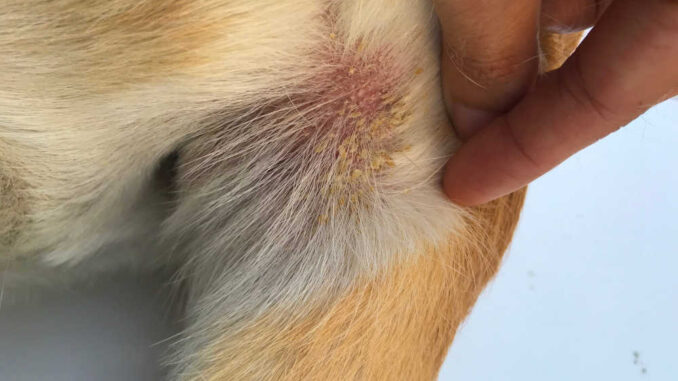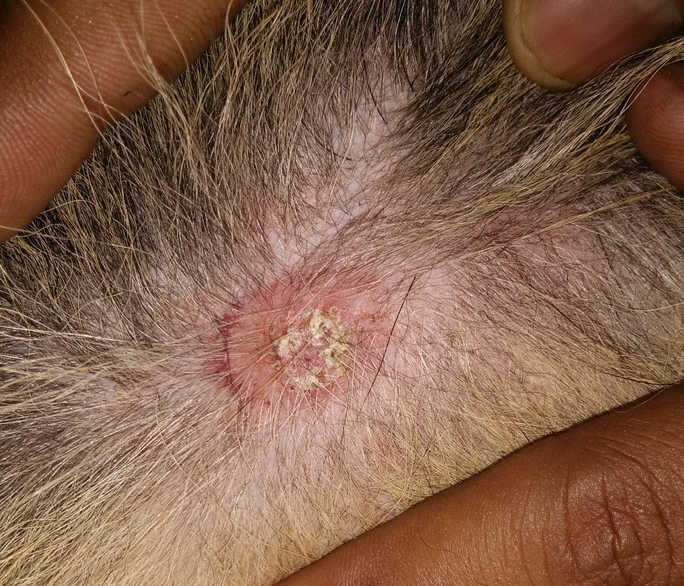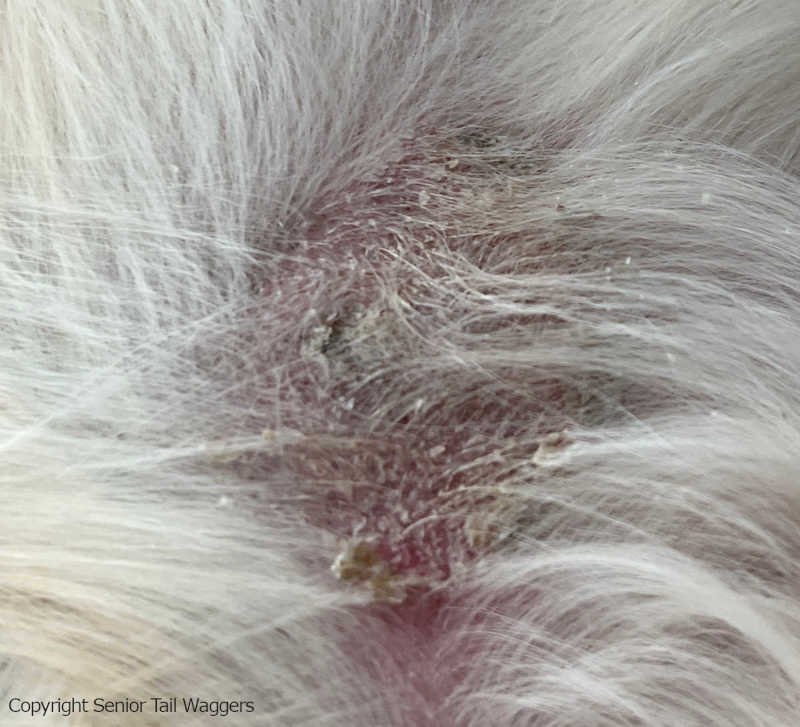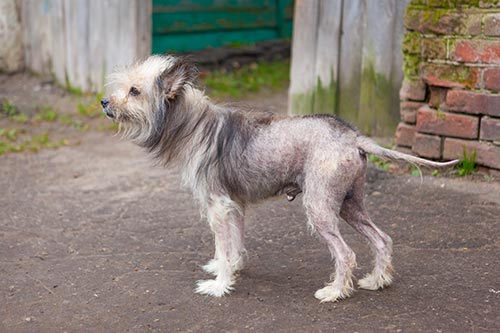
This article was updated on March 14th, 2024

Noticing your dog is suddenly losing fur and has developed dry and flaky skin can be quite an alarming find for any owner. When I see a dog with these signs in my clinic, I’ll want to know all about the dog’s history and symptoms. For example:
- Has your dog had skin issues before?
- Does your dog show any other symptoms? (some dogs may also be itchy and start to chew or lick at their skin.)
- What is your dog’s age and breed?
This information alone will help us tremendously in determining what is going on. Figuring out what has caused the dry skin and fur loss in the first place is key when it comes to deciding on a treatment plan.
Top conditions causing both hair loss and dry flaky skin
1. Fungal and bacterial skin infections
Skin infections can present in a number of different ways and signs can include flaky, dry skin as well as fur loss and reddening of the skin.
Infections can lead to itching, which will cause the dog to traumatize their skin, leading to damaged skin and broken fur. Skin infections are common and will generally be triggered by other issues such as parasites or allergies.

Dogs can be affected in any location, but we more commonly see skin infections where there are skin folds and places like the face, rump, and armpits.

Some milder skin infections may be managed from home with a medicated wash, but most dogs will require veterinary attention and courses of medication such as antibiotics or antifungals. Learn more about skin infections (with more pictures) and home remedies.
2. Hormonal disorders such as Cushing’s disease or Hypothyroidism
Typically, we will see hormonal disorders in the middle-aged to older population. As well as skin issues, we’d expect to see some other signs such as weight changes, lethargy, bloating, panting, or excess thirst. Fur loss can be caused by hormone imbalance, and this tends to be symmetrical and non-itchy.

These dogs have a weakened immune system and can develop thinner skin; both of which will leave them open to developing secondary skin infections. View more pictures of dogs with Cushing’s disease. A veterinarian visit is needed to diagnose a hormonal condition, and this usually entails blood tests and urine tests. For most, treatment will mean daily medication as well as addressing any co-existing skin disease.
3. Nutritional deficiencies
Though less common nowadays thanks to the availability of good quality commercial dog dogs, nutritional deficiencies do still occur. This is sometimes seen in dogs fed a homemade or raw diet or in those with malabsorption disorders.
As well as signs like dandruff and fur loss, we may also notice lethargy, a failure to thrive, and diarrhea. The body does not have the micronutrients it requires to maintain equilibrium and the immune system will be weakened and less able to fight off infection.

If an owner suspects a deficiency, a vet visit is needed to determine what the body is lacking and to provide supplementation, which may be given as injections initially. If the owner is making a home-made diet, they will need to consult with a canine nutritionist, to get the balance right.
4. Parasites
External parasites, including fleas and mites, frequently lead to fur loss and damaged, flakey skin due to the trauma they cause to the skin as well as the damage done by the itchy dog.
Licking, scratching, and rubbing all lead to broken skin, damaged fur, and bald patches. In the case of demodectic mange (when a dog is not especially itchy), the fur loss is due to inflammation, which adversely affects the hair follicles.

Owners should keep their pets up to date with effective parasite prevention. If parasites are suspected, a vet visit is wise so they can be issued the correct treatment, which may include a topical medicine and a specific wash.
5. Atopic dermatitis
Allergies are highly prevalent in dogs, and they can react to a wide range of things, including certain foods, mites, dust, and pollen. Signs can include pink skin, dandruff, itching, and fur loss.

For most dogs, signs come and go and may be worse at certain times of the year. It is useful for owners to keep a ‘reaction diary’ to try and determine their pet’s triggers.
Many atopic dogs will develop secondary skin infections as their skin barrier is weakened and the dog is constantly introducing bacteria and yeast when they lick and scratch. Damaged hair follicles result in thin fur and bald patches.

While owners can help to minimize symptoms at home by avoiding allergens, using medicated washes, and starting skin supplements, vet visits are needed to control allergic flare-ups. This usually means issuing some strong anti-itch medicine to break the itch-scratch cycle, as well as antibiotics to address secondary infections.
What to do when you notice dandruff and hair loss in dogs
Owners may notice dry skin or dandruff when petting or grooming their dog. On closer inspection, they might see areas of thin fur or fur loss. A small amount of dandruff may be the norm for some breeds, particularly in the winter when we turn the central heating on and dry out our dog’s skin. However, excess flakey skin, or any balding, is worth talking to the vet about.
Ho2w to prevent dandruff at home
Dandruff can occur due to overbathing, which strips the natural oils from the dog’s skin. So, it is sensible to consider bathing your dog less. For many dogs, a bath a few times a year is all they need. Always use a shampoo made for dogs and not dish soap or human shampoo.
Dead skin cells will normally be shed alongside fur, but sometimes get ‘trapped’ if a dog is not groomed enough. Owners should be brushing their dog’s coat every day, to remove dead and flaked off skin.
For those prone to dry skin, starting a skin supplement is an easy thing to try. This will usually be a capsule, powder, or oil that is added to the dog’s food once daily.
- Supporting Allergy Immunity for Dogs – Our allergy treats for dogs help relieve your furry friend's painful inflammation. These soft chews help reduce your pup's hotspots, dandruff, and shedding while supporting healthy skin and a shiny coat
When to visit the vet
A vet visit is advised if a dog’s skin is flakier than usual or we are noticing other signs such as crusting, oozing, a bad smell, fur loss, thin fur, or itching.
While you may try to manage milder signs at home, if you do not see improvement within a week or two, it is best to have your dog checked over.
Treatment options and likely costs
Which treatment is needed will depend on why your dog has developed this flakey skin and fur loss. For some dogs, they may simply need a parasite preventative. For other dogs, managing their skin will be a lifelong endeavor, with regular checkups and a multi-modal treatment regime consisting of anti-itch medicine, shampoos, and supplements.
What normal dog skin should look like
You should get familiar with what your dog’s skin usually looks like. For most dogs, it is a pale pink color and some areas will have darker brown and black splotches of pigment. Areas like the groin, belly, and armpits will naturally have less fur. The skin should be smooth and pale, without any areas of scabs, crusting, or flaking.

Frequently Asked Questions
• Should I be concerned if my dog is experiencing hair loss along with dry flaky skin or dandruff?
Yes, any hair loss is abnormal and a sign of an underlying issue that should be looked into.
• How will a veterinarian diagnose the underlying cause of my dog’s dry flaky skin or dandruff?
Your vet will take into consideration your dog’s signalment (age, sex, and breed) and medical history. They should examine the skin and perform a full check-over. Oftentimes, additional tests such as skin scrapes and swabs are undertaken.
• Can I use over-the-counter products to treat my dog’s dry flaky skin or dandruff?
Milder dandruff can be treated with OTC products like shampoos and skin supplements, yes.
Related posts:
Disclaimer: This website's content is not a substitute for veterinary care. Always consult with your veterinarian for healthcare decisions. Read More.













Be the first to comment